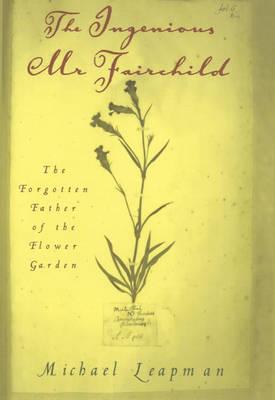 |
| David Austin named this rose after Thomas Fairchild |
Believe or not, The Ingenious Mr Fairchild
is the name of this rose. I am glad to report that it has just produced its
first blooms after a rescue attempt. Our plant had been in the wrong place for
many years. I may have reported that, at the beginning of lockdown, I decided
to pot it up and relocate. It was only at that point that I discovered its
strange name, The Ingenious Mr Fairchild, and the story behind it which, to me,
is as surprising as its name
 |
| Mr Fairchild with his blog |
According to the record, Thomas
Fairchild was the first person to produce a plant through crossbreeding. Perhaps
it would more accurate to say he was the first person recorded to have
crossbred – surely, this must have been tried in ancient civilisations like the
Chinese or the Persians – who knows?
Fairchild produced a new variety
by crossing a Sweet William with a Carnation. This was in 1717 and the result
was called Fairchild’s Mule – rather apt. It was a modern plant breeder, David
Austin, who decided to name one of his roses after Fairchild in 2003.
He looks a jolly character. Rather unlike the rose named after him which has rather sharp thorns. Looking again, I suspect he was both sharp and jolly - the twinkle in the eye is the giveaway
 |
| Adenium Obesum - the Desert Rose |
Plants for
You
Take a look at the top right of
this page. Immediately above “About me” you will see a clickable link “Plants
for You”. This takes you to a page which sets out the plants we can supply at
the moment. It also indicates what is coming along soon
I shall be adding some photographs
as not all of the plants / varieties will be familiar to many readers. For
example, I have come across a really attractive houseplant Adenium Obesum
– sometimes call the Desert Rose. If you are looking for something special, it
may fit the bill
So, please use the Plants for You
label – as I say, look top-right on this the home page and click there (it will take a few days to work on the photos)
Treat
yourself!
Many readers of this blog have
been ‘lockdown sheltering’ and will have been relieved to hear of a reprieve – the
date I heard was July 6 but now seems to be the end of the moth. So,there is still time to read a book. In checking
out the Thomas Fairchild story, I stumbled across the biography which suggested
to rose-breeder David Austin the inviting epithet: Ingenious. Not only so, but I
also found that Blackwell’s still have a stock of the book which they are
selling at only £2.99 – who could resist such a bargain especially when you discover
that P&P is free? (List price is £14.99 - gets even better!)
And, perhaps, I should say again
that your old Codger has absolutely no commercial connections at all. I have
used Blackwell’s in the past and found them to be a good company to deal with.
The book details are here
Now, here are a few matters on
which I am said I would report back to readers ...
Remember I was into multiplication
by division? In practice, the arithmetic turned out somewhat disappointing. This
may be of interest to you if you have primulas that you wish to increase
Some plants turned out to be too
small to divide. About 50% split OK and so doubled. A couple of plants were so
keen to flower, I did not have the heart to stop them
It's too early to judge, but I guess we shall obtain get a 30% increase - much below my expectations
It's too early to judge, but I guess we shall obtain get a 30% increase - much below my expectations
 |
| Pond-side primulas |
True grit
You may have noticed how, on gardening
programmes, you hear things like, “Add plenty of grit to so the mix is really free-draining”.
Ever tried buying horticultural grit? In most garden centres you pay a lot for
a little. I thought I had found the solution: buy the grit that poultry-keepers
use. I bought a 25kg sack via Amazon only to find that there are different
sorts. I ordered the wrong type that included crushed shells
 |
| The right stuff this time |
Mine your own
peat
When I mentioned the manure
mountain last week, I indicated that it had a history. How long, I know not,
but long enough for some of the material to have become peat – or as close to
it as makes no difference, as you can see it the photo. I have used this as
top-dressing for the tomatoes in the greenhouse. Before I put this down, I gave
them a sprinkling of wood ash that I had saved from a rather fierce BBQ fuelled
by some old fencing panels. Nothing goes to waste when you are aiming for self-sufficiency!
The wood ash, which had to kept dry, should provide a boost to the production
of fruit (note the verbal connection: potash / potassium)
 |
| What I now call Rowley peat |
Next edition
That's all for today, folks. Look out for the next edition on Friday when I plan to tell you about Garden Codger's Secret. Ssshh - don't tell anyone ...



No comments:
Post a Comment